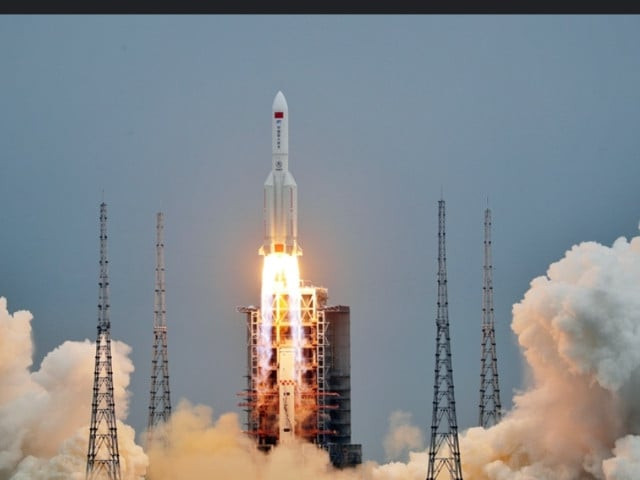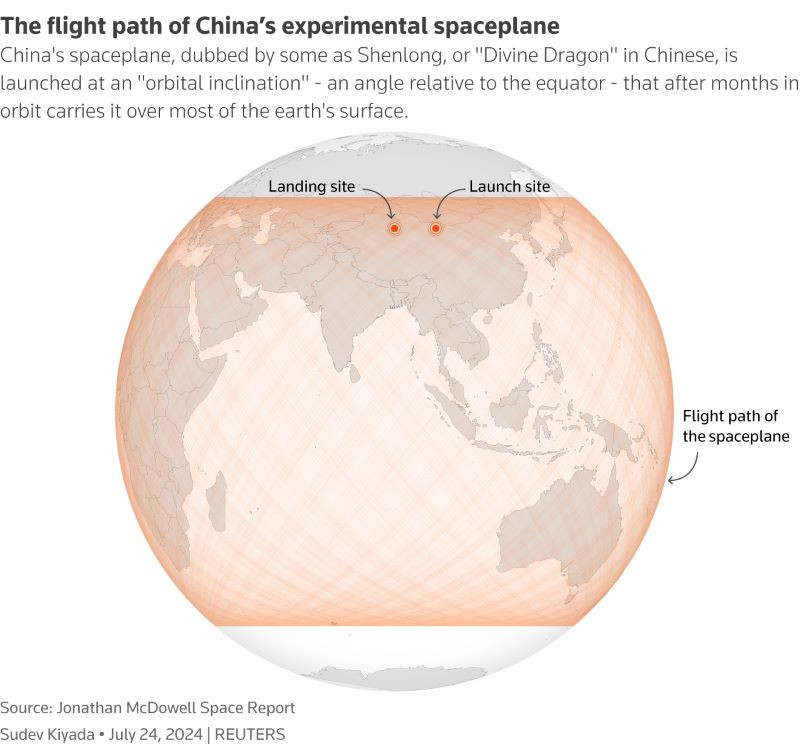China's covert spaceplane likely testing 'dual use' technology: experts
China in 2021 test flew a hypersonic glide vehicle under the concept of fractional orbital bombardment system

China's shadowy, uncrewed reusable spacecraft, which launches atop a rocket booster and lands at a secretive military airfield, is most likely testing technology but could also be used for manipulating or retrieving satellites, experts say.
The spacecraft, on its third mission, was in June observed releasing an object, moving several kilometres away and then manoeuvring back to within a few hundred metres of it.
"It's obvious that it has a military application, including, for example, closely inspecting objects of the enemy or disabling them," said Marco Langbroek, a lecturer in optical space situational awareness at Delft University of Technology in the Netherlands.
"But it also has non-military applications. Gaining experience with this kind of grab and release is good if you want to for instance ... refuel your own satellites."
As militaries worldwide develop complex satellite networks, a reusable spacecraft that can interfere with them could have immense value, Langbroek and three other experts said.
China has never disclosed what technologies the spacecraft has tested, nor has the spaceplane been publicly photographed since it began operating.
The US first launched its uncrewed Boeing, X-37B spaceplane in 2010, while Russia has recently launched several satellites that US officials suspect may be weapons, a charge Russia has denied.
China's spaceplane is most likely testing technology, much like the X-37B, said Victoria Samson, chief director of space security and stability at the Secure World Foundation thinktank in Washington, D.C.
"I don't think that either has a whole lot of military utility, to be honest," Samson said. "I am guessing that both are technology demonstrators."
China's ministry of defence did not immediately respond to a request for comment. State media outlet Xinhua has noted the launches and landings of the spaceplane, which it refers to as a "reusable test spacecraft".
The current flight of the Chinese spaceplane began in December 2023. The previous mission, which also involved putting a separate object in space and retrieving it, launched in August 2022 and lasted 276 days, according to tracking data. Its first flight was in September 2020 and lasted two days.
"We see breathtaking advancements by the People's Republic of China in space," said General Stephen Whiting, commander of US Space Command, noting that his organisation did not know what objects the spaceplane had released.
"Any space activity that they undertake, we assume has some dual use in the national security realm," Whiting said. "We're always interested in understanding what could that dual use be, and trying to make sure that we have a good knowledge of that."
Mystery craft
Little is known about China's spaceplane.
Tracking data show it launches from Jiuquan, in north central China, and lands at an airfield in Lop Nur, in the country's Xinjiang region.

The airfield is linked to a site once used for nuclear testing and is tightly controlled by the military, said Jonathan McDowell of the Harvard-Smithsonian Center for Astrophysics.
Data show it has changed its altitude from common orbits of roughly 350 kms (217 miles) to 600 kms and back, he said.
It is thought to be roughly the same size and shape as the X-37B, which is about 30 feet (9.14 m) long and has spent as long as 908 days in orbit at altitudes of up to 38,000 km.
Given it has spent months in space, China's spaceplane is also assumed to be uncrewed, although it has flown atop China's only human-rated booster, the Long March 2F.
The US Space Shuttle, which operated from 1981 to 2011, was about the size of a 737 airliner and could carry a crew of seven but spent no longer than 17 days in orbit. The Soviet Union developed a large crewed spaceplane called Buran, which made one automated orbital flight, a 3-hour journey in 1988.
The Space Shuttle performed 10 classified missions out of 135 flights, leading the Soviet Union to consider it a military spaceplane and develop Buran, said Jeffrey Lewis, director of the East Asia Nonproliferation Program at the Center for Nonproliferation Studies.
"We don't want to look at this (Chinese) spaceplane the same way the Soviets looked at the Shuttle," he said. "A lot of these are just experiments rather than well-thought-out military platforms."
Military uses
The apparent experiments in orbit with releasing and retrieving objects mirror those of the United States' X-37B.
The X-37B's missions have all been classified, but are described as taking experiments to space and back, and exploring "reusable vehicle technologies that support long-term space objectives", according to Boeing.
How well those experiments go could influence the duration of the mission. Testing a cutting-edge sensor, for instance, could yield intelligence so useful that the government may want to keep it in space for longer before bringing it back to the lab, McDowell said.
Inspecting or disabling an adversary's satellites is another potential military capability. Some countries, including the US, China, India and Russia, already have ground-based anti-satellite missiles.
Orbital weapons have long been taboo, and weapons of mass destruction in space are banned by the 1967 Outer Space Treaty.
China in 2021 test flew a hypersonic glide vehicle as part of a Cold War-era concept known as a fractional orbital bombardment system, which launches a warhead partially into orbit, allowing it to strike with little warning from unusual trajectories.
But attacking from orbit using a spaceplane offers little advantage over ballistic missiles or cruise missiles, Lewis said.
Two senior Indian military officers, speaking on condition of anonymity as they were not authorised to speak to the media, said that although the exact purpose of the Chinese spaceplane was unclear, India was concerned.
"The spacecraft in question is definitely alarming," said one of the officers. "Things like this can always have dual purposes. India is keenly watching."



















COMMENTS
Comments are moderated and generally will be posted if they are on-topic and not abusive.
For more information, please see our Comments FAQ